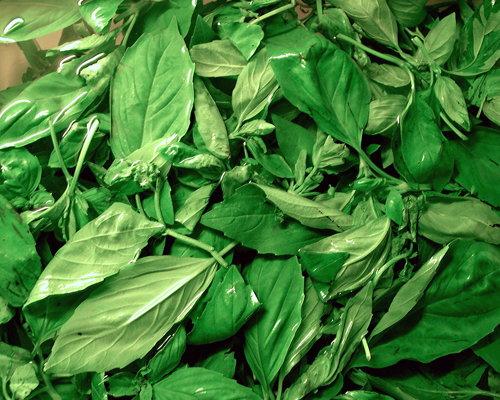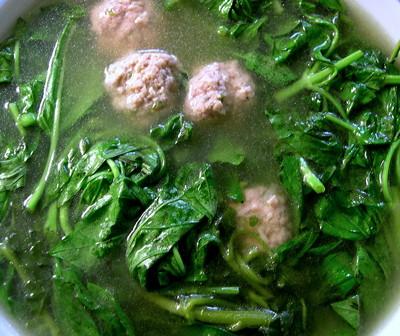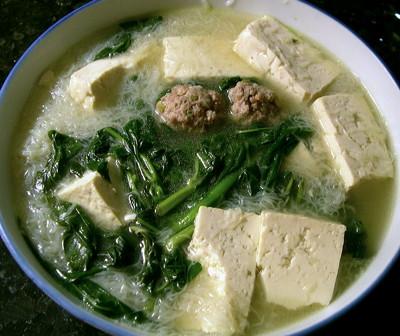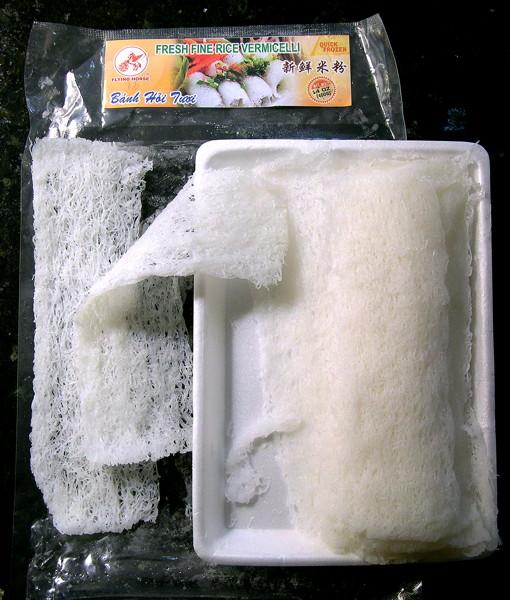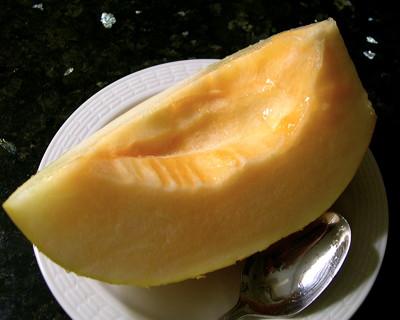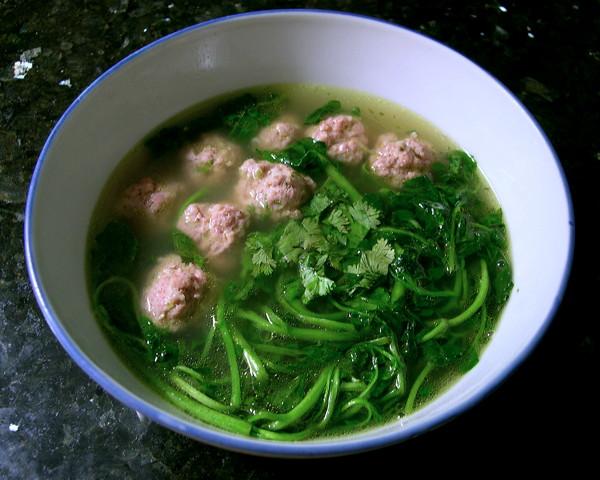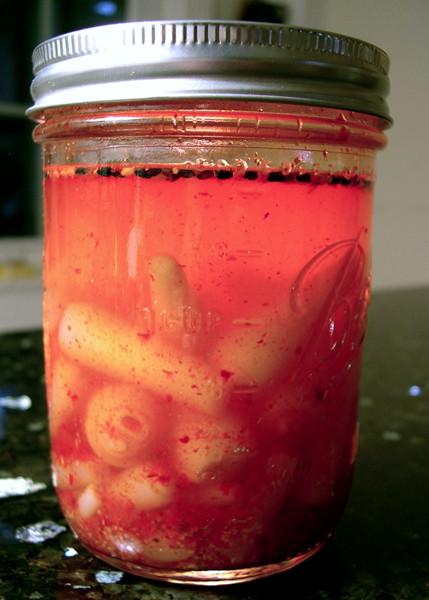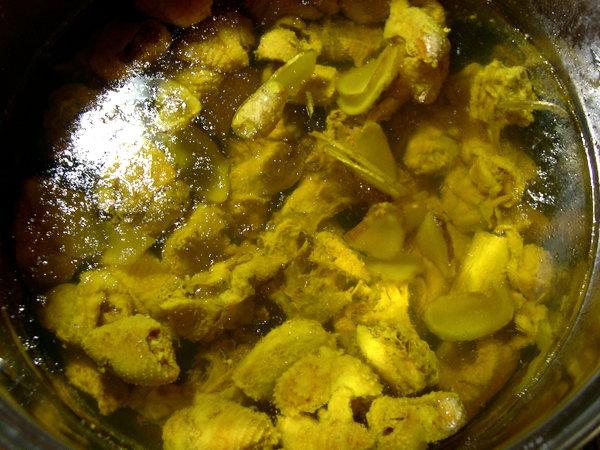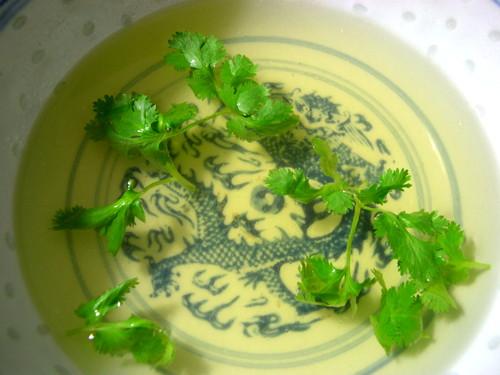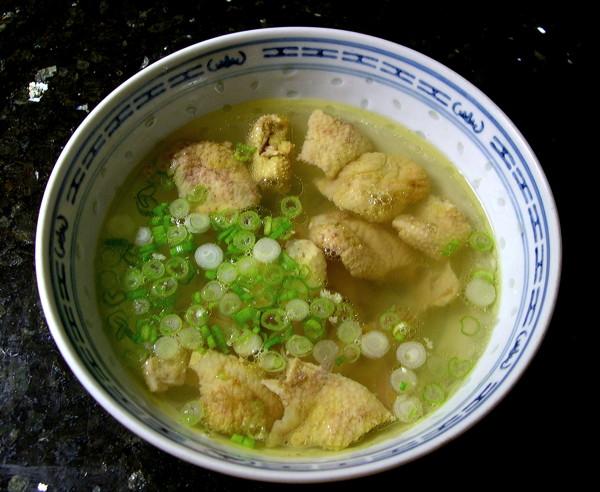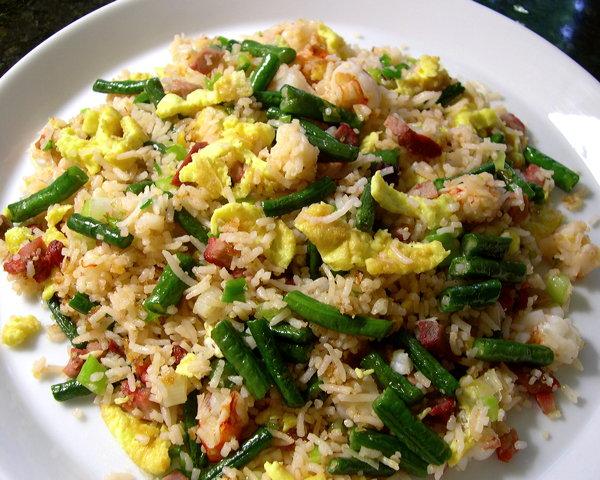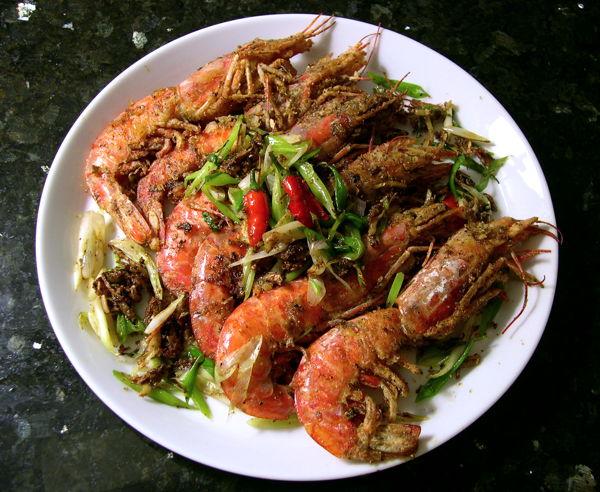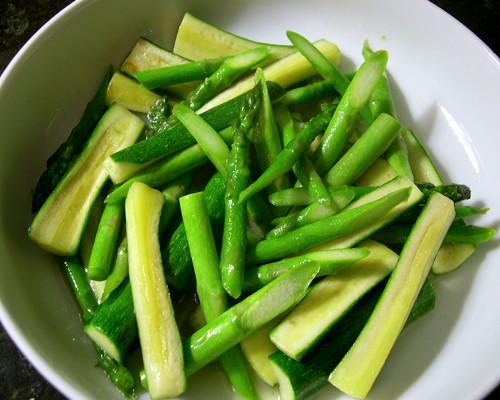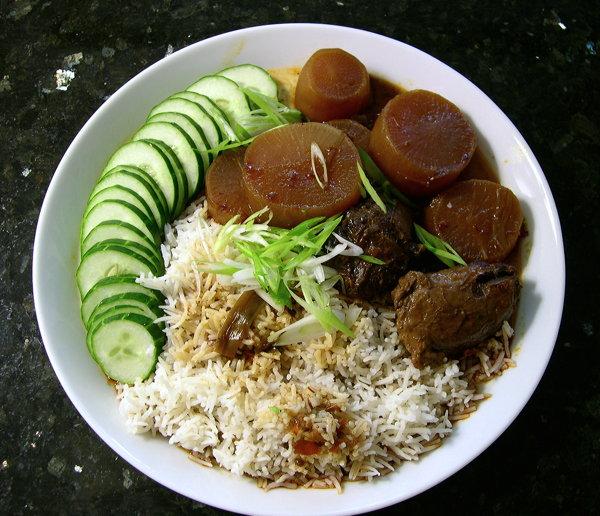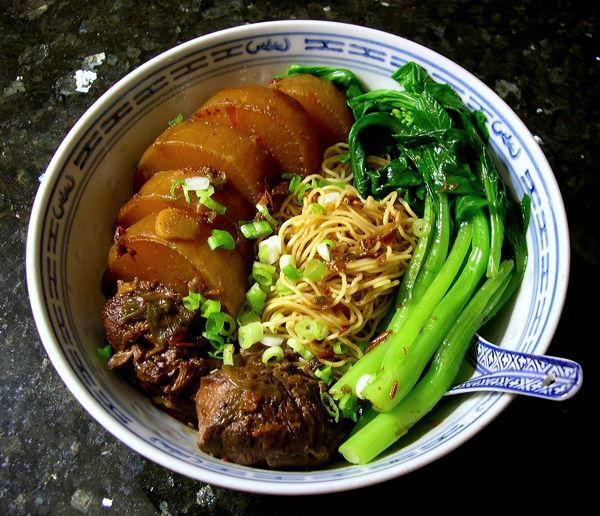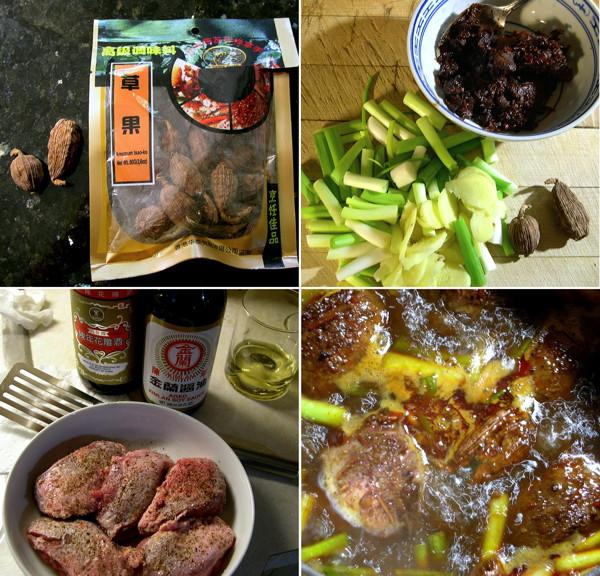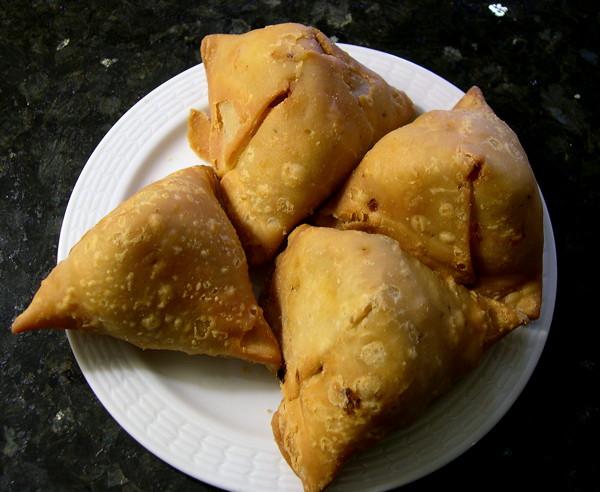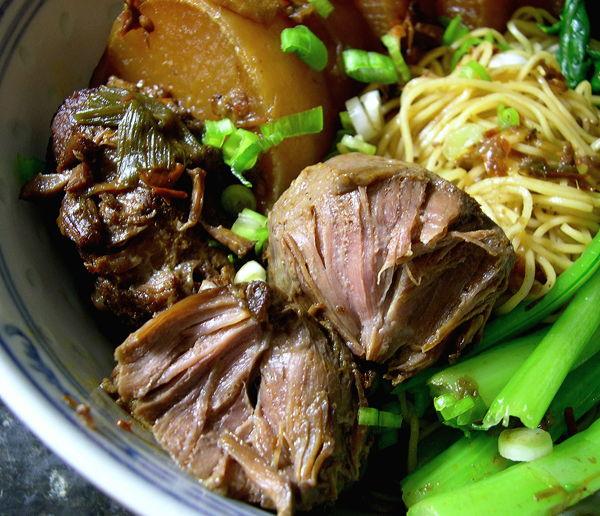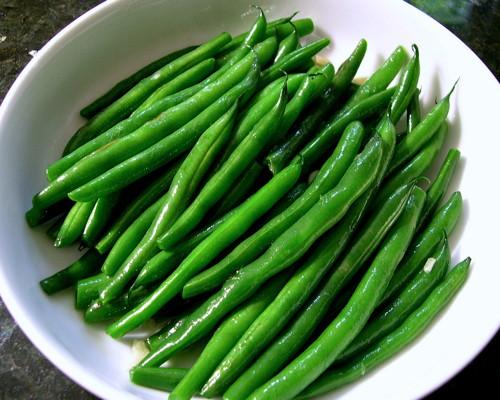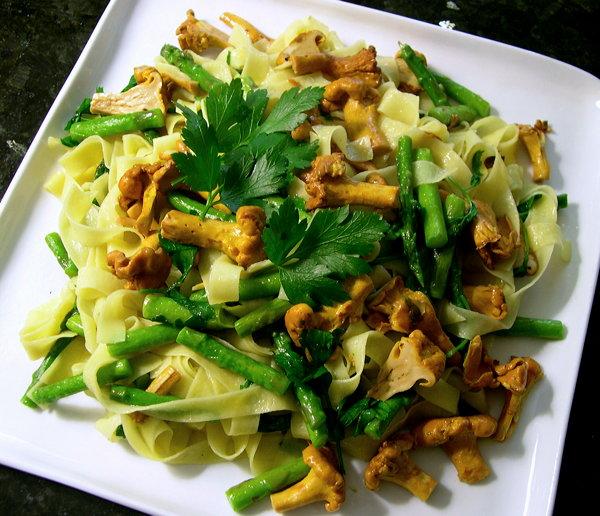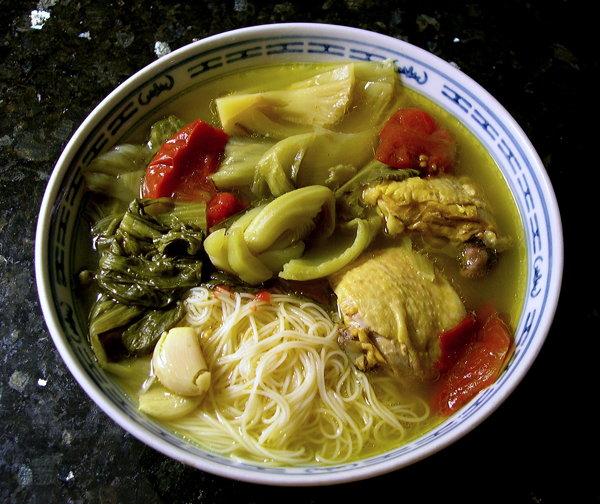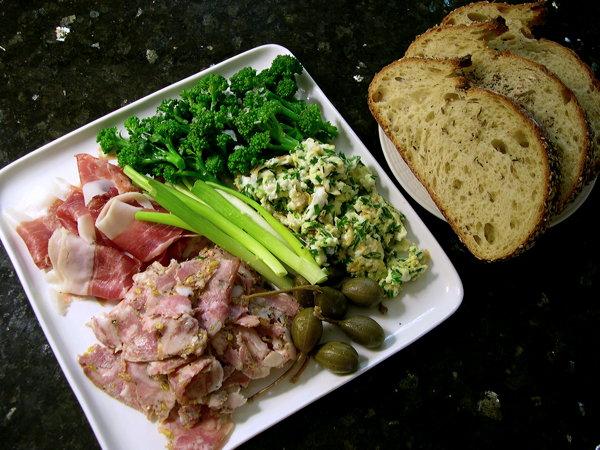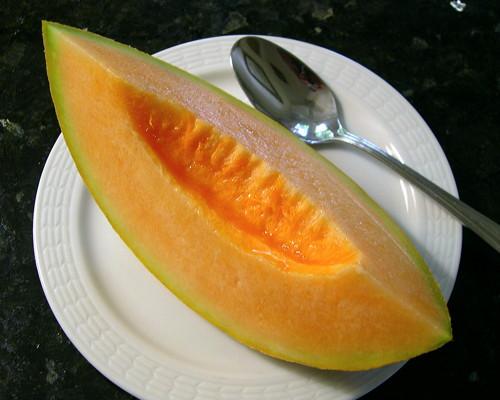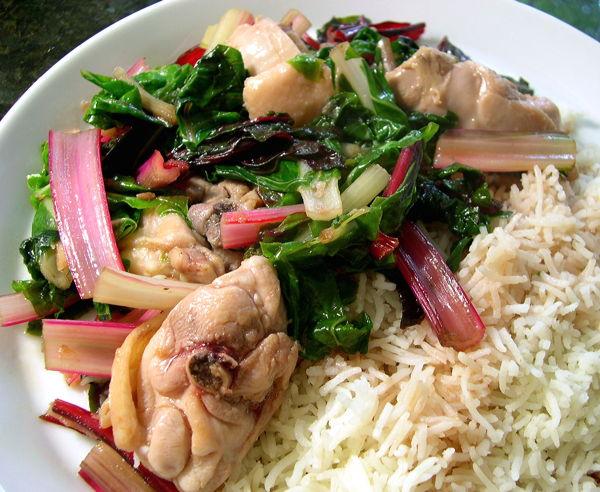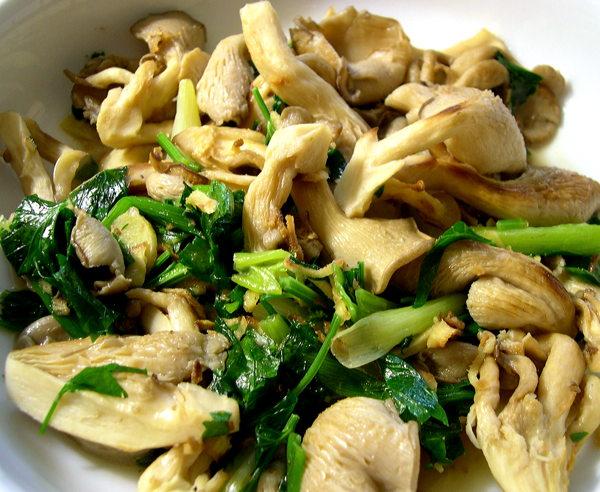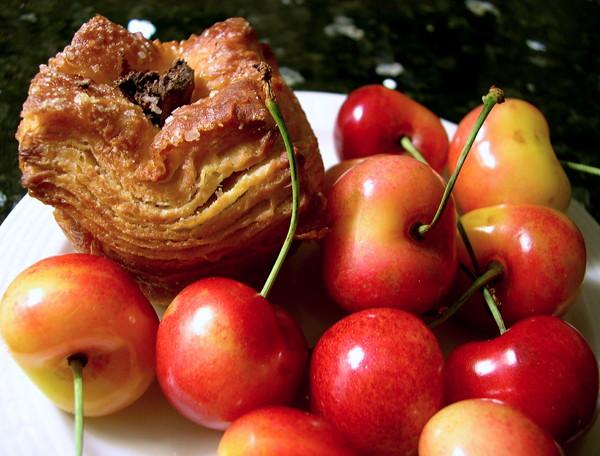-
Posts
3,810 -
Joined
-
Last visited
Content Type
Profiles
Forums
Store
Help Articles
Everything posted by huiray
-
I always add sugar in some form to my vinaigrettes. Sometimes even hon-mirin. To me, without the sugar the vinaigrette is unbalanced.
-
Consider using basil as a vegetable. I've posted examples on the dinner (and other "meal threads" in the past) where I used basil just like I would spinach or other leafy vegetbles.
-
Second & Third Acts of a Soup. :-) Well, I still had some meatballs and some watercress in a fair bit of broth from the soup posted here...so I added in a few dollops of gelled chicken stock, water, and handfuls of trimmed sweet basil, used as a vegetable. (I often do this) Simmered to rewarm before adding the basil to wilt into it then simmering for less than a minute more. But – I was also chomping on this-and-that, and managed to eat only part of the bowl of soup. Soooo...later, I boosted the soup with more water & gelled chicken stock, added in chunks of firm tofu, and at the end put in several "pieces"/"sheets" of "fresh" fine rice noodles (Vietnamese-type). This I demolished. :-) The trimmed basil soaking... About 3/4 of the batch shown in the picture; there's about 5-6 inches of trimmed basil below the surface... ;-) Soup, Act 2. Soup, Act 3. The fine rice noodles used. And, afterwards, two slices of the cantaloupe-honeydew hybrid that Van Antwerp's Farm grows...
- 476 replies
-
- 11
-

-
Oops, sorry, this is put out by Kim Lan, not LKK. ETA: I have added in a correction to the original post. This one (金蘭 甘醇油膏). Image set. Well, to each his or her own. I'll happily use what I like, you use what you like. Nowadays I try to avoid telling people what they should or should not eat. I list stuff that I use, but that's it - simply what I used.
-
Soup. Pork meatballs (ground pork, sweet Italian ground mix, finely chopped scallions, sea salt, ground white pepper), chicken broth, watercress wilted in towards the end. Chee cheong fun. Steamed rice noodle rolls (豬腸粉)¶ [ 李牌 / Lee's Noodle] with a sauce mix** poured over halfway through steaming, plus sesame seeds; plated on oak leaf lettuce heart leaves; dressed w/ sliced scallions & coriander leaves. ** "Luscious Soy Sauce" [LKK], oyster sauce [LKK], Shaohsing wine, water, sesame oil, white pepper, hoisin sauce [LKK]. ETA: Correction - this is made by Kim Lan, not LKK; and the description in English they use nowadays is "Luscious Soy Paste". When I first started buying this a few years ago they called it "Luscious Soy Sauce" and that stuck in my head. ¶ The name for this commonly-found foodstuff literally means "pig intestine noodle/powder/plaster" character-by-character. See the additional commentary here for more.
- 476 replies
-
- 14
-

-
I might as well put this in here. I found a bag of "forgotten" ramps in a corner of my fridge recently...the green tops were mush, of course, but the bulbs had survived, although with some stains and brown areas on the outside. So I trimmed them, removed the outer layer of the bulbs, and pickled the remaining cores of the bulbs. Momofuku pickled ramp bulbs. Using this recipe. It took quite a few days for the bulbs to absorb liquids etc and sink to the bottom. Was at room temp, currently held in the fridge. Yes, I've been eating some of them. Eh, can't say I'm enraptured by them.
-
Yesterday's batch. After decanting (the stuff pourable without the chicken pieces falling out) through paper towels in a large metal sieve, which also served to trap (separate off, rather) much of the fat – a couple ladles of the stock, w/ some coriander leaves on top. All of the final decant, with some light thumping, with dregs & sediment getting through – with retrieved/plucked off pieces of dark meat, some of the oyster nuggets from the chicken back pieces, and chicken skin; zapped in the MW to reheat. Chopped scallions. Some Maldon salt. Greatly enjoyed. The fat retained by the paper towels allowed to drip through slowly into another bowl then was chilled and the fat solids taken off the residual liquid layer for other uses.
-
Cantonese-style Yeung Chow-type fried rice chez huiray. Couple of farm-fresh eggs beaten w/ a little water, some oil, and a few grinds of white pepper; then fried in a very hot pan w/ generous oil. The bubbly lightly browned (on purpose) omelette was turned over for maybe 15-20 secs then removed to a plate while not completely set yet (somewhere between 1 and 2 minutes total frying time) and sliced up into strips. Medium-hot oil, chopped smashed garlic, Chinese long beans cut into ~ 1½ inch lengths, roughly diced char-siu (Cantonese barbeque pork), kosher salt, stir around, splash some water on and cover for a minute, high flame; cover taken off, day-old rice added, everything stirred around on high flame. Everything was pushed to the sides and a well created in the center, some oil poured in, de-shelled de-veined "big head red shrimp" (see previous post) cut into bite-sized pieces added and stir-fried quickly (about 20-30 seconds then the rice & everything else folded over and stirred in well. Chopped scallions (lots) went in, stirred/folded in; then the reserved egg strips went in, folded in, the cover put on and the flame shut off after 30 secs or so. The cover was left on for about a minute or so, then taken off and everything tossed/folded/stirred around. Served. About half of the fried rice was plated as shown. Eat.
- 476 replies
-
- 15
-

-
Ah, thanks. I've seen young/juvenile romanesco with barely developed ridges - not dissimilar to where they show up as just the slight ridges at the heads in your photo of them. But then again, maybe they were cocozelle instead... Thanks again. Yes, they're lovely squashes, fine tasting and with "creamy" flesh.
-
Heh. The ones you show (in your pickage picture) are young Costata Romanesco, I think?
-
Couple of meals. ---------------------------------------------- More of the chillied pork cheeks w/ daikon (from here). Served over rice and w/ sliced cucumber ("Tasty Green"; from [Funny Bone Farm]) & sliced scallions. ---------------------------------------------- Salt & Pepper Shrimp, the night's version. I used "大頭紅蝦" ("Big Head Red Shrimp") picked up from a local Chinese grocery – I strongly suspect they were Argentine Red Shrimp. These were pretty red and were around 7 inches long on average. (And yes, the taste (after cooking) & texture was lobster/crayfish-like and what I expected from either Royal Reds or, indeed, said Argentine Red Shrimp which I have had before.) Washed shrimp patted dry, floured w/ corn starch, shallow-fried (big pan), reserved on paper towels. Dry-toasted ground black+white pepper plus kosher salt, reserved. Oil in hot pan, julienned ginger & sliced garlic, de-seeded red Thai chillies, lots of trimmed scallions, reserved shrimp added back in, gently turn/fold over, reserved toasted pepper & salt sprinkled over, folded/turned over. Plated. Plus "flash stir-fried" thin asparagus and halved baby zucchini. Several bowls of white rice.
- 476 replies
-
- 13
-

-
@ProfessionalHobbit, thanks for the additional commentary about Sam Wo. Appreciated. So much for that place, then. :-(
-
I took a look at the dinner menu (and also the lunch menu) of this place. I don't know the past or present reputation of this place, but just from the menu I would hesitate to order something like Mongolian Beef from what seems to be a Cantonese place that seems to specialize in Noodle dishes and rice-combination dishes. The tough kai-lan was a bummer and they should have done better, yes. The duck congee? Maybe that wasn't what they excelled at in their repertoire of congees? It's not something that is very often eaten for dinner in (again) a Cantonese restaurant, anyway... for lunch or breakfast, more likely** - maybe they served the dregs of it augmented with fresh (under-prepared) congee? But also, Cantonese taste profiles are much more muted than, say, Szechuanese or Hunanese - is that a factor? Just wondering. Many Chinese restaurants have a certain "skew" towards some dishes being excellent - due to the particular abilities and proclivities of the chefs, whether or not it is a famed restaurant or a hole-in-the-wall place. Many menu items are there because of "expectations" but they may not be what the chef is good at. Yes, even at the best places. But when all is said and done, maybe this place is simply no longer what it was before if it was good to start with. Yes, true, some would also say that if something is on one's menu it should be excellent, otherwise why put it there? But that argument is more relevant to high-end Western cuisine restaurants. Lower-end ones would have that familiar panoply of all sorts of things, while many Chinese restaurants fall into the trap of what I referred to above. ** Even if I myself, personally, would eat congee for the night-time meal if I felt like it. :-)
-
I confess I find it hard to understand why folks who have an abundance of zucchini plants and/or zucchinis/squashes to harvest don't simply pick them when they are teeny, preferably with the flowers on, or when they are just very little guys. One does not HAVE to let them develop to full size. The tiny guys with flowers on both reduces the crop and also affords one the ingredient for other sorts of wonderful dishes and preps. Or, even, just simply pick the flowers. Squash flower soup, which requires a lot of flowers, would swiftly reduce the incipient crop of squashes/zucchinis. In the event that the plants "get away from you" - why not simply just leave the excess zucchinis alone, or trash/mulch them. There will be more coming, if you are not picking the flowers.
-
Chillied braised pork cheeks w/ daikon. Eaten w/ skinny wonton noodles & blanched choy sum. Pork cheeks [Fischer Farms] (via Goose the Market), salted & black-peppered; browned in peanut oil & reserved. Pixian Doubanjiang sautéed/stir-fried in residual oil + a bit more, then scallions, ginger, aged soy sauce, Shaohsing wine added; followed by lightly-crushed black cardamom pods, water & gelatin-heavy chicken stock, hon-mirin. Simmered briefly. Pork cheeks added back in. Simmered several hours. Along the way... Went to get daikon & other stuff [Asia Mart] and also dropped by an Indian place. Interlude – potato & pea samosas [Namaste Plaza]. Yum. Pork cheeks fished out & reserved, peeled daikon cut into rounds added in, more water added in plus more Shaohsing wine plus more freshly-bought scallions. Simmered for an hour plus. Pork cheeks went back in, simmered some more, maybe half-to-three-quarters of an hour more. Close-up of one of the cheeks, in the assembled bowl of stuff, split open with a gentle push from a pair of chopsticks.
- 476 replies
-
- 11
-

-
I somewhat suspect the haziness is not mist but smog?
-
Heh. Yes, as Liuzhou said above, 炸灌肠 (or 炸灌腸 traditional) should really be "fried sausage". It might be even better to say "fried sweet potato starch sausage", as that is what it (usually) is made with. From poking around I gather it is an old Peking snack food, with some distinctive seasonings - and did indeed used to be made by stuffing the seasoned sweet potato starch into pig intestines, then cooking (e.g. by steaming) then the sausage sliced up and fried then served with that garlicky dipping sauce I presume you got. It seems the taste of the fried intestines was once supposed to be part of the flavor profile in the final dish. :-) But they dispensed w/ the intestine casing in more recent times and simply formed the starch/dough into the shape of a sausage.** ** As an aside, "腸" (Cantonese Jyutping coeng4/coeng2; but popularly transcribed as "cheong") is part of the name of several Chinese foodstuffs - "lap cheong", as a more familiar example to Western folks, literally means "waxed intestine" character-by-character but the compound term is understood to refer to those Chinese sausages of seasoned and cured meats in the shortish tubular-like "sausage" form. "Cheong fun", as another, literally means "intestine noodle/plaster/powder" character-by-character but the compound refers to those smooth-tasting/textured rice noodles usually seen as sheets of rice noodle, often rolled up into a tubular form. (Ditto "chee cheong fun", which is always rolled up) In all these cases the name plays upon the supposed resemblance of the food item to the round, tubular, longish form that intestines usually take. :-) ETA: I would caution English-speaking folks that whenever they see "cheong" it does not automatically mean "intestine", as various terms/characters in Chinese would also have the transliteration of "cheong" (in faux Cantonese), including instances with different tones, all of which can mean very different things.
-
Indeed ventresca is very very good. Seconded that one should try it at least once, preferably just by itself (yum!) with minimal accompaniments that let the tuna shine. Still, the good canned/jarred stuff will sort of "dissolve" into the dish if used in a recipe where cooking and stirring is involved - so if one wants discrete chunks of tuna the (good) non-ventresca stuff is probably indicated. :-)
-
Yes you did.
-
Sautéed green beans. Chanterelles w/ pasta. Charentes-Poitou butter, trimmed chanterelles, trimmed asparagus, salt, just-cooked wet Cipriani tagliarelle, chopped parsley. The tagliarelle.
- 476 replies
-
- 13
-

-
Harm Choy Tong. Water, chicken thighs, pre-soaked wet pickled mustard, sliced galangal, tamarind slurry from a pulp block, wet pickled plums, garlic, salt, rice vinegar, palm sugar, chopped-up Cherokee Purple tomato, extra oil, simmer. Eaten w/ Fuzhou-type thin wheat noodles (min6 sin3)
- 476 replies
-
- 10
-

-
Various stuff on a plate. From 9 o'clock going anti-clockwise: Prosciutto Rossa [La Quercia], Salame Cotto [Smoking Goose] (both via Goose the Market); pickled caperberries [Delicias], farm-fresh eggs [Schacht Farm] marbled w/ chopped Western chives (from my deck), very briefly blanched bunching broccoli [Nading Farm] drizzled w/ Maussane-les-Alpilles Fruité Noir olive oil & with Maldon salt scattered on it; and scallions in the center. Plus slices of semolina bread [Amelia's] on the side plate. A slice of Jackson County cantaloupe [Van Antwerp's Farm].
- 476 replies
-
- 13
-

-
Are you sure you are thinking of actual "Peking Duck" in NYC's Chinatown? What you would get commonly in most of the restaurants, especially those ducks hanging in the windows or served not-from-the-window in more upscale places would probably be CANTONESE ROAST DUCKS. There are I believe only a few restaurants in NYC Chinatown which serve ACTUAL Peking Ducks, and they would (to my knowledge) make it very clear on their menus and signage that they were serving Northern-Chinese PEKING ducks. Most of the other restaurants, of Cantonese/Toishan/Fuzhou origins, would be serving Cantonese-type roast ducks. They are two different things. And, I dare say most of those Cantonese roast ducks would be done using Pekin ducks (the BREED of ducks commonly available and used), as distinct from Peking Duck (the DISH). Another poster here on eG some time ago talked about sourcing "Peking Ducks" from NYC Chinatown for his new upscale grocery-cum-eatery in Brooklyn and it was pointed out to him to that he was probably NOT thinking of actual PEKING DUCKS but Cantonese Roast Ducks.
-
Regarding the "hot pot" as shown here – For me, the term that is associated with this style of eating/cooking-at-the-table is "steamboat". Like shown in these images (certainly the ones at the upper/top part of the entire image set), at least when I was growing up and in the milieu I was brought up in, which was more Cantonese/Southern Chinese Diaspora. One talked about going out for "steamboat", not "hot pot"; the expected cooking liquid would be a starting broth or even water, and the cooking vessel would be these center-chimneyed pots that were brought out to the table. The term "hot pot" for us tended to conjure up other versions where a pot is used without the central chimney (e.g. Sichuanese, Mongolian, etc) with or without a divided pot; and/or Japanese-style a la sukiyaki or shabu-shabu and the like.** We used our own chopsticks (no "intermediate serving pairs") for both the cooking as well as the eating, plus little sieves as shown in some of the images in the Google set above. Nobody got paranoid about "someone else's utensils in my food" (besides, the hot broth took care of things...) unless they had done something really objectionable such as constantly licking their chopsticks or using it to pick their nose (not that anyone ever did that last thing). **ETA: Or, if still with Cantonese/Southern Chinese cuisines, it suggested stuff like rice done in those claypots - like these... ETA2: "Fondue", for me and my folks and friends, ALWAYS meant the European/Swiss/German thing , particularly where cheese was used; and those long-handled small two-pronged forks were de rigeur.
-
Sautéed blue oyster mushrooms. Hot pan w/ oil, julienned scraped ginger, salt, trimmed scallions, trimmed blue oyster mushrooms [Shamrock Farm], chopped parsley. Chicken & Swiss Chard. Medium-hot oil, chopped smashed garlic, chopped chicken thighs, fish sauce, Shaohsing wine, hon-mirin, trimmed washed Peppermint Swiss Chard & Red Swiss Chard [Funny Bone Farm], some water, etc. Eaten w/ white rice. ETA: And later, more of the chicken-chard w/ rice; together with leftover tofu-straw mushroom-basil soup, augmented w/ more basil from the deck. Then, for dessert, a nice Kouign-Amann [Amelia's] plus some of the fattest, juiciest, sweetest Rainier cherries I've had in a while, from Northern Indiana via Goose the Market.
- 476 replies
-
- 12
-




